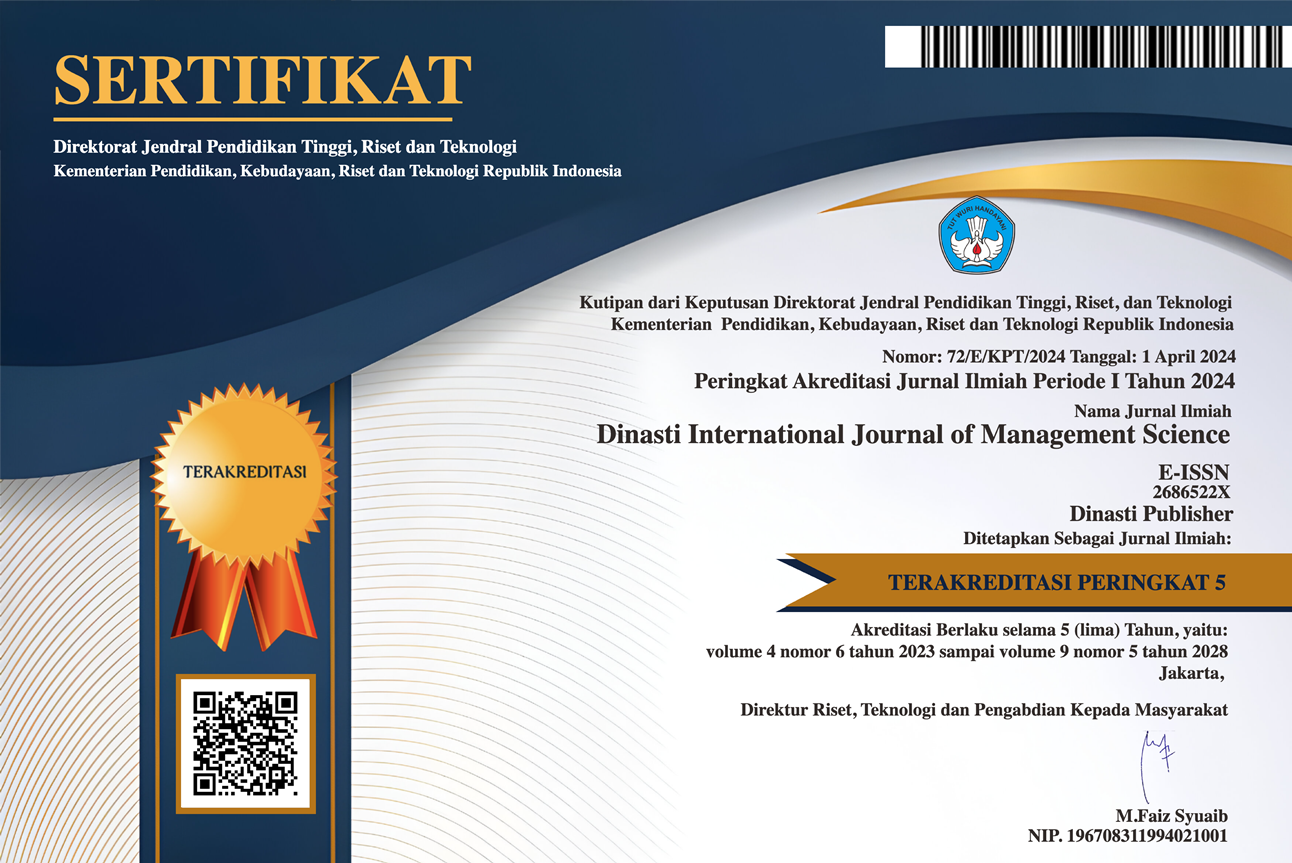Analysis of the Impact of CR and DAR on NPM at PT Bank BNI Tbk for the Period 2013-2023
DOI:
https://doi.org/10.38035/dijms.v6i3.3885Keywords:
Current Ratio, Net Profit Margin, Debt to Asset RatioAbstract
This study aims to examine how the Current Ratio (CR) and Debt to Asset Ratio (DAR) influence the Net Profit Margin (NPM) of Bank Negara Indonesia (BNI) over the period from 2013 to 2023. The data used in this research consists of the bank's annual financial reports spanning 11 years, sourced internally from the bank. The research method applied is multiple linear regression analysis, with data processing carried out using SPSS software. The findings show that neither the Current Ratio nor the Debt to Asset Ratio significantly impacts the Net Profit Margin. The coefficient of determination is low (R² = 0.077), indicating that these two variables explain only 7.7% of the variation in Net Profit Margin. The F-test results also confirm that these variables do not have a significant collective effect on Net Profit Margin. Based on these results, it is recommended that BNI focus on other factors, such as cost control and operational efficiency, to enhance its profitability in the future.
References
Bank Indonesia. (2023). Laporan Tahunan Bank Indonesia 2023.
Brealey, R. A., Myers, S. C., & Allen, F. (2017). Principles of Corporate Finance (12th ed.). McGraw-Hill Education.
Ghozali, I. (2015). Analisis Laporan Keuangan (6th ed.). Gramedia.
Kasmir, K. (2017). Analisis laporan keuangan (10th ed.). Raja Grafindo Persada.
Markonah, M. (2021). Analysis Relates to The Role of Premium Income, Claim Expenses, Investment Result and Risk Based Capital (RBC) Against the General Insurance Companies’ Profits Income (Case Study on General Insurance Which Registered in The Indonesia Stock Exchange. Dinasti International Journal of Economics, Finance & Accounting, 2(2), 135–149. https://doi.org/10.38035/DIJEFA.V2I2.856
Markonah, M., & Prasetyo, J. H. (2022). The Effect of Corporate Governance on Financial Performance: Evidence from Islamic Banks in Indonesia. Journal of Asian Finance, Economics and Business, 9(6), 45–52. https://doi.org/10.2991/aer.k.201221.098
Moyer, R. C., McGuigan, J. R., & Kretlow, W. J. (2014). Contemporary Financial Management (14th ed.). Cengage Learning.
Otoritas Jasa Keuangan. (2023). Statistik Perbankan Indonesia.
Prasetyo, J. H., & Riyanto, S. (2019). The Effect of Emotional Intelligence, Learning Interest, and Discipline on Students’ Learning Outcomes in SMP Negeri 141 Jakarta. International Journal of Innovative Science and Research Technology, 4(5), 973–980. www.ijisrt.com973
Riley, G. (2016). Corporate governance and profitability in emerging markets. International Journal of Business Studies, 20(4), 101–118.
Sekaran, U., & Bougie, R. (2016). Research methods for business: A skill building approach (7th ed.). John Wiley & Sons.
Sugiyono. (2019). Metode Penelitian Kuantitatif, Kualitatif dan R&D. Alfabeta.
Wiharso, G., Akbar Basudani, W., Theresia Simamora, V., & Mulyadi, H. (2022). Digital Banking: Assessing Customer Satisfaction through Product Quality. Dinasti International Journal of Economics, Finance & Accounting, 3(4), 412–418. https://doi.org/10.38035/dijefa.v3i4.1436
Wiharso, G., Prasetyo, J. H., Prakoso, B. S., & Fabrianto, L. (2022). The Effect Of Mobile Banking Product Quality On Customer Satisfaction Of Indonesian Sharia Bank Jakarta Wolter Monginsidi Branch. Matriks: Jurnal Sosial Dan Sains, 3(2), 80–88. https://matriks.greenvest.co.id/index.php/jmt/article/view/90/134
Downloads
Published
How to Cite
Issue
Section
License
Copyright (c) 2025 Gani Wiharso, Wahid Akbar Basudani

This work is licensed under a Creative Commons Attribution 4.0 International License.
Authors who publish their manuscripts in this journal agree to the following conditions:
- The copyright on each article belongs to the author(s).
- The author acknowledges that the Dinasti International Journal of Management Science (DIJMS) has the right to be the first to publish with a Creative Commons Attribution 4.0 International license (Attribution 4.0 International (CC BY 4.0).
- Authors can submit articles separately, arrange for the non-exclusive distribution of manuscripts that have been published in this journal into other versions (e.g., sent to the author's institutional repository, publication into books, etc.), by acknowledging that the manuscript has been published for the first time in the Dinasti International Journal of Management Science (DIJMS).
















































